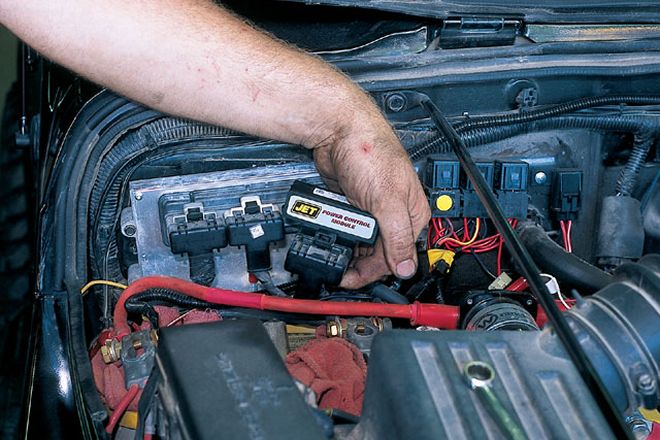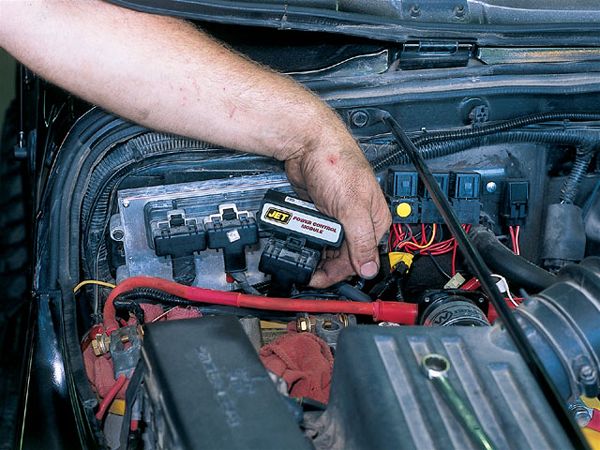
 Ken Brubaker
Senior Editor, Four Wheeler
Ken Brubaker
Senior Editor, Four Wheeler
 First, you need to disconnect the negative battery cable. The Jet installation instructions will tell you where the stock ECU is located on your vehicle. In the case of our '97 Wrangler, it was located under a snap-on dust cover on the firewall. After locating your ECU, simply remove the stock ECU connector and plug the Jet module into the stock connector, making sure the module is installed tightly on the stock connector. Some applications will require removal of a dust cover, and this will not reinstall without modifications. Start the vehicle and verify that the "check engine" light is not on and everything is working properly. It's that simple!
First, you need to disconnect the negative battery cable. The Jet installation instructions will tell you where the stock ECU is located on your vehicle. In the case of our '97 Wrangler, it was located under a snap-on dust cover on the firewall. After locating your ECU, simply remove the stock ECU connector and plug the Jet module into the stock connector, making sure the module is installed tightly on the stock connector. Some applications will require removal of a dust cover, and this will not reinstall without modifications. Start the vehicle and verify that the "check engine" light is not on and everything is working properly. It's that simple!
We may lament the fact that most new trucks today sport more computer power than the Apollo space modules (it's true, we've heard), but the upside to all this electronic gadgetry is that companies like JET Performance Products have figured out a way to tweak more power from our 4x4s by creating computer modules that plug into a truck's Electronic Control Module (ECM) to help liberate more horsepower and torque. Just think about it: Jet claims an increase of 10-30 hp (depending on your application) without unbuttoning the engine, and with few, if any, modifications.
Obviously, the research and development that goes into a product like this is significant. The ECM in your vehicle receives readings from various sensors throughout your rig's systems, including manifold vacuum, coolant temperature, throttle position and rpm, and then processes this information and adjusts spark timing, air/fuel ratio and other parameters according to the tables stored in the chip's memory. Jet's engineers recalibrate these tables for maximum horsepower and torque under various driving conditions. This process is time-consuming and requires a significant amount of hands-on testing using sophisticated equipment. Jet offers two types of modules for most applications. The Stage 1 module is for stock applications, while the Stage 2 module is for more heavily modified vehicles. The Stage 1 is simply plug 'n' play, while the Stage 2 requires premium unleaded fuel, an after-cat exhaust system and a Jet 180 degree thermostat-this final piece due to its more aggressive ignition recalibration.
Testing by Jet Performance Products shows that on a Mustang chassis dyno, a stock Jeep 4.0L engine generates 127 hp at 5,000 rpm and 111 lb-ft of torque at 4,000 rpm. With the addition of a Jet Stage 1 module, this is increased by 10 hp to 137 hp and torque is increased 12 lb-ft to 123 lb-ft. Not bad for simply plugging in a module.